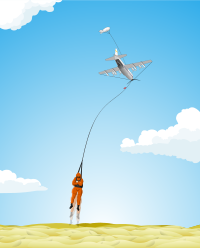-
From Wikipedia, the free encyclopedia
This article needs additional citations for verification. (January 2013) The Fulton system in useThe Fulton surface-to-air recovery system (STARS) is a system used by the Central Intelligence Agency (CIA), United States Air Force and United States Navy for retrieving persons on the ground using aircraft such as the MC-130E Combat Talon I. It involves using an overall-type harness and a self-inflating balloon which carries an attached lift line. An MC-130E engages the line with its V-shaped yoke and the person is reeled on board. Red flags on the lift line guide the pilot during daylight recoveries; lights on the lift line are used for night recoveries. Recovery kits were designed for one and two-man retrievals.The Fulton system in use from below
This system was developed by inventor Robert Edison Fulton, Jr., for the Central Intelligence Agency in the early 1950s. It was an evolution from a similar system[1] that was used during World War II by American and British forces to retrieve both personnel, and downed assault gliders following airborne operations. The earlier system did not use a balloon, but had a pair of poles that were set in the ground on either side of the person to be retrieved, with a line running from the top of one pole to the other. An aircraft, usually a C-47 Skytrain, would trail a grappling hook and engage the line, which was attached to the person to be retrieved.
Contents
The Skyhook system
Experiments began in 1950 with the CIA and Air Force. Using a weather balloon, nylon line, and 10- to 15-pound weights, Fulton made numerous pickup attempts as he sought to develop a reliable procedure. Successful at last, he had his son photograph the operation. Fulton then took the film to Admiral Luis de Florez, who had become the first director of technical research at the CIA. Believing that the program could best be handled by the military, de Florez put Fulton in touch with the Office of Naval Research. Thanks to de Florez's interest, Fulton received a development contract from ONR's Air Programs Division.This section may need to be rewritten entirely to comply with Wikipedia's quality standards, as it is a close copy of cia.gov source. (January 2016)
Over the next few years, Fulton refined the air and ground equipment for the pickup system. Based at El Centro, California, he conducted numerous flights over the desert, using a Navy P2V Neptune for the pickups. He gradually increased the weight of the pickup until the line began to break. A braided nylon line with a test strength of 4,000 pounds (1800 kilograms) solved the problem. More vexing were the difficulties that were experienced with the locking device, or sky anchor, that secured the line to the aircraft. Fulton eventually resolved this problem, [clarification needed] which he considered the most demanding part of the entire developmental process.
By 1958, the Fulton aerial retrieval system, or Skyhook, had taken its final shape. A package that easily could be dropped from an aircraft contained the necessary ground equipment for a pickup. It featured a harness, for cargo or person, that was attached to a 500-foot (150 m), high-strength, braided nylon line. A portable helium bottle inflated a dirigible-shaped balloon, raising the line to its full height.
The pickup aircraft sported two tubular steel "horns" protruding from its nose, 30 feet long and spread at a 70° angle. The aircraft would fly into the line, aiming at a bright mylar marker placed at the 425-foot (130 m) level. As the line was caught between the forks on the nose of the aircraft, the balloon was released and at the same time the spring-loaded trigger mechanism (sky anchor) secured the line to the aircraft. As the line streamed under the fuselage, it was snared by the pickup crew, using a J-hook. It was then attached to a powered winch and pulled on board. The aircraft also had cables strung from the nose to the wingtips to keep the balloon line away from the propellers, in case the catch was unsuccessful.Illustration of operating principle of the Fulton recovery system
Fulton first used instrumented dummies as he prepared for a live pickup. He next used a pig, as pigs have nervous systems close to humans. Lifted off the ground, the pig began to spin as it flew through the air at 125 mph (200 km/h). It arrived on board uninjured but in a disoriented state. Once it recovered, it attacked the crew.[2]
Later the US Navy tested the Fulton system fitted to modified S-2 Tracker carrier-based antisubmarine patrol aircraft for use in rescuing downed pilots. It is unknown whether a Fulton equipped S-2 was ever used on a combat mission.
First human pickups
The CIA had secretly trained Special Activities Division paramilitary officers to use a predecessor system for human pickups as early as 1952. The first human recovery mission authorized for operational use of this "all American system" took place in Manchuria on 29 November 1952. CIA C-47 pilots Norman Schwartz and Robert Snoddy were trained in the aerial pickup technique towards the end of 1952. CIA paramilitary officers John T. Downey and Richard G. Fecteau, themselves hurriedly trained in the procedure during the week of 24 November, were to recover a courier who was in contact with anti-communist sympathizers in the area. The mission failed when Chinese forces downed the aircraft with small arms fire, capturing survivors Downey and Fecteau. The British allegedly also used the American system for personnel.[2]The Fulton balloon
The first human pickup using Fulton's STARS took place on 12 August 1958, when Staff Sergeant Levi W. Woods of the U.S. Marine Corps was winched on board the Neptune.[3] Because of the geometry involved, the person being picked up experienced less of a shock than during a parachute opening. After the initial contact, which was described by one individual as similar to "a kick in the pants", the person rose vertically at a slow rate to about 100 feet, then began to streamline behind the aircraft. Extension of arms and legs prevented spinning as the individual was winched on board. The process took about six minutes.
In August 1960, Capt. Edward A. Rodgers, commander of the Naval Air Development Unit, flew a Skyhook-equipped P2V to Point Barrow, Alaska, to conduct pickup tests under the direction of Dr. Max Brewer, head of the Navy's Arctic Research Laboratory. With Fulton on board to monitor the equipment, the Neptune picked up mail from Floating Ice Island T-3, also known as Fletcher's Ice Island, retrieved artifacts, including mastodon tusks, from an archaeological party on the tundra, and secured geological samples from Peters Lake Camp. The high point of the trials came when the P2V dropped a rescue package near the icebreaker USS Burton Island. Retrieved by a ship's boat, the package was brought on deck, the balloon inflated, and the pickup accomplished.
Project Coldfeet
The first operational use of Skyhook was Project COLDFEET, an examination of an abandoned Soviet drift station. Two agents parachuted to station NP 8 in May 1962. After 72 hours at the site, a pick-up was made of the Soviet equipment that had been gathered and of both men. The mission yielded information on the Soviet Union’s Arctic research activities, including evidence of advanced research on acoustical systems to detect under-ice submarines and efforts to develop Arctic anti-submarine warfare techniques.[2]
Later use
The Fulton system was used from 1965 to 1996 on several variants of the C-130 Hercules including the MC-130s and HC-130s. Despite the apparent high-risk nature of the system, only one fatal accident occurred in 17 years of use (in 1982). The increased availability of long-range helicopters such as the MH-53 Pave Low, HH-60 Pave Hawk and MH-47 Chinook, and the MV-22 Osprey and CV-22 Osprey tilt-rotor aircraft, all with aerial refueling capability, caused this system to be used less often. In September 1996, the Air Force Special Operations Command ceased maintaining the capability to deploy this system.
In popular culture
The Skyhook was seen in the 1965 James Bond film Thunderball. In the final sequence, James Bond and his companion Domino Vitali are rescued at sea by a modified Boeing B-17 equipped with the Fulton system.[4]
The Skyhook system was also featured prominently in the 2008 movie, The Dark Knight. First mentioned by Lucius Fox as a means of re-boarding an aircraft without it landing,[5] the system is attached to a Lockheed L-100 Hercules. It is used by Batman to kidnap the corrupt Chinese accountant Lau and escape the Hong Kong police, so that Batman could bring him back to Gotham City to face Harvey Dent, where Lau became an informant.[6] Lau had previously fled to Hong Kong and stayed in his company's skyscraper offices (the real-life International Finance Centre 1[7]) to avoid US custody and extrication, necessitating the kidnapping and a method to get back to the plane without it landing.[8]
The Skyhook is also featured as a core gameplay mechanic in the videogame Metal Gear Solid V: The Phantom Pain.[9]
See also
- Special Patrol Insertion/Extraction
- United States Air Force#Personnel Recovery
- Special Activities Division
References
- Video: B-29s Rule Jap Skies,1944/12/18 (1944). Universal Newsreel. 1944. Retrieved 20 February 2012.
- "Robert Fultons Skyhook and Operation Coldfeet". Center for the Study of Intelligence. Central Intelligence Agency. Retrieved 7 December 2008.
- "500-Foot High Jump". Popular Mechanics, April 1960, p. 111.
- "Not just a flight of fancy: 'Skyhook' that rescued James Bond from the ocean at the end of Thunderball was designed to recover real-life CIA agents from behind enemy lines". Mail Online. Retrieved 12 January 2016.
- Christopher Nolan (2008). The Dark Night (Motion Picture). 28 minutes in. ASIN B001GZ6QC4. OCLC 259231584.
Bruce Wayne: "And what about getting back into the plane?" Lucius Fox: "I'd recommend a good travel agent." Bruce Wayne: "Without it landing." Lucius Fox: "Now that's more like it. The CIA had a program back in the '60s for getting their people out of hotspots called Skyhook. We could look into that."
- Christopher Nolan (2008). The Dark Night (Motion Picture). 37 minutes in. ASIN B001GZ6QC4. OCLC 259231584.
- Pulver, Andrew. "Top 10 films set in Hong Kong". theguardian.com. The Guardian. Retrieved 27 October 2015.
- Hall, Peter. "Did You Know the Plane Extraction Scene from 'The Dark Knight' Used Real CIA Technology?". movies.com. Retrieved 27 October 2015.
Monday, March 14, 2016
Skyhook - Fulton surface-to-air recovery system
Fulton surface-to-air recovery system
Subscribe to:
Post Comments (Atom)








No comments:
Post a Comment